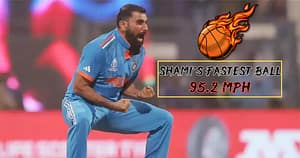The Indian cricket team is renowned for producing some of the fastest bowlers in the world. These speed demons can send shivers down the spines of even the most seasoned batsmen. we will delve into the world of Indian cricket’s Thunderbolts and explore what makes them so deadly on the pitch.
From the exploits of the legendary Kapil Dev to the raw pace of Jasprit Bumrah, Indian cricket has a proud tradition of producing fast bowlers who can intimidate and dominate their opponents. These Thunderbolts possess not only raw speed but also a wide range of skills that make them a force to be reckoned with.
We will take a closer look at some of these speedsters and examine their techniques, strategies, and the impact they have made on the game. Whether it’s the fiery yorkers of Mohammed Shami or the fierce bouncers of Ishant Sharma, each bowler brings their own unique style to the field, keeping batsmen on their toes.
The fastest bowlers in Indian cricket history
Traditionally known for their spin prowess, Indian cricket has, in recent years, seen a surge in young pace bowlers who can consistently clock over 150 kmph. Here’s a look at some of the fastest bowlers India has produced:
- Umran Malik: This young tearaway from Jammu and Kashmir currently holds the record for the fastest delivery by an Indian bowler, a scorching 157 kmph thunderbolt he unleashed in the IPL 2022 season. Malik consistently bowls in the high 150s, making him a genuine threat to any batsman.
- Mayank Yadav: The newest entrant to the fast lane, Mayank Yadav impressed everyone with his raw pace in the IPL 2024 season. Clocking the second-fastest delivery by an Indian ever at 156.7 kmph, Yadav has announced himself as a future prospect for the national team.
- Jasprit Bumrah: While not the quickest on the block, Jasprit Bumrah’s deceptive pace and accuracy have made him one of the most lethal bowlers in the world today. He can consistently hit the high 140s and has the ability to swing the new ball, making him a nightmare for opening batsmen.
- Mohammed Shami: Another bowler known for his accuracy more than sheer pace, Mohammed Shami can still crank it up when needed. He has the ability to bowl long spells at a lively pace, making him a valuable asset in the Test format.
- Irfan Pathan: A former left-arm fast bowler, Irfan Pathan was a genuine pace threat in his prime. He was known for his swing bowling and ability to generate good bounce from the pitch. While his pace declined later in his career, Pathan remains one of the fastest bowlers India has ever produced.
These are just a few of the many fast bowlers who have represented India over the years. With the growing emphasis on pace bowling in modern cricket, it’s likely that we will see even faster bowlers emerge from India in the years to come.
Famous Indian fast bowlers throughout history
While spin has traditionally been India’s strength in cricket, the country has also produced some legendary fast bowlers who terrified batsmen with their raw pace, swing, and accuracy. Here’s a look at some of the most famous Indian fast bowlers throughout history:
Early Pace Pioneers (Pre-1990s):
- Mohammad Nissar: A stalwart in the early days of Indian Test cricket, Nissar was known for his raw pace and aggression. He was a true pioneer who paved the way for future generations of fast bowlers.
- Kapil Dev: Often regarded as India’s greatest all-rounder, Kapil Dev was also a genuine quick bowler in his younger days. His fiery pace and swing bowling were instrumental in India’s historic 1983 World Cup victory.
The Swing Generation (1990s-2000s):
- Javagal Srinath: Considered by many to be the fastest bowler India has ever produced, Srinath was a tall, lanky pacer with a smooth action and genuine express pace. His accuracy and ability to swing the new ball made him a nightmare for opening batsmen.
- Venkatesh Prasad: Srinath’s bowling partner for many years, Prasad was another fast bowler known for his swing and seam bowling. He formed a potent opening bowling attack with Srinath that troubled many a batting line-up.
- Zaheer Khan: Arguably the most successful Indian fast bowler in terms of wickets taken, Zaheer Khan wasn’t the quickest, but he made up for it with his exceptional swing bowling skills. His ability to reverse swing the old ball was a particular weapon, and he led the Indian bowling attack for over a decade.
Modern Pace Attack (2000s-Present):
- Ishant Sharma: A tall, lanky pacer with a smooth action, Ishant Sharma has been a workhorse for the Indian team for many years. While his pace has dipped slightly over time, he remains a consistent wicket-taker and a valuable asset in Test cricket.
- Jasprit Bumrah: The current leader of the Indian pace attack, Jasprit Bumrah may not be the fastest bowler, but his unconventional action and deceptive pace make him a very difficult proposition for batsmen. His accuracy and ability to swing the new ball have made him one of the best fast bowlers in the world today.
- Mohammed Shami: Another key member of the current Indian pace attack, Mohammed Shami is known for his aggressive bowling style and ability to generate good pace. He forms a potent partnership with Bumrah and has been instrumental in India’s recent success in Test cricket.
These are just a few of the many fast bowlers who have left their mark on Indian cricket history. From the raw pace of early pioneers to the swing and accuracy of modern-day bowlers, Indian fast bowlers have come a long way, and they continue to be a crucial part of the team’s success.
The art of fast bowling – techniques and skills
Fast bowling is an art form in cricket, a thrilling spectacle that combines raw athleticism, intricate technique, and strategic thinking. It’s about unleashing a thunderbolt that tests the batsman’s reflexes and technique. Here’s a deep dive into the techniques and skills that make a fast bowler a nightmare for batsmen:
The Foundation: Building Pace
- Run-up and Delivery Stride: The foundation for fast bowling lies in a smooth and controlled run-up that gathers momentum. The bowler gradually accelerates, transferring this momentum into a powerful stride that utilizes the entire body. This coordinated movement from the legs to the core and upper body is crucial for generating pace.
- Grip and Wrist Position: The grip on the cricket ball plays a vital role. A good fast bowling grip allows for seam presentation (discussed later) and control over the delivery. The wrist position, whether upright or slightly cocked, can influence the ball’s movement through the air.
- Strength and Conditioning: Fast bowling demands exceptional physical fitness. A strong core, powerful legs, and flexible shoulders are essential for generating pace and maintaining accuracy over long spells. Regular strength training and conditioning exercises are a must.
Weapons of Deception: Mastering Swing and Control
- Seam Position and Swing: A slight alteration in how the bowler holds the seam (the stitching on the ball) can create deceptive movement in the air. By presenting different parts of the seam, bowlers can make the ball swing in or out, leaving batsmen guessing. Mastering swing bowling is a prized skill that can bamboozle even the best batsmen.
- Accuracy and Line & Length: While raw pace is impressive, line and length are equally important. Bowlers need to deliver the ball consistently at the desired spot, making it difficult for the batsman to score runs. Accuracy allows them to exploit weaknesses in the batsman’s technique and create wicket-taking opportunities.
Variations in Deliveries:
- The Yorker: A deadly weapon that lands right at the batsman’s toes, the yorker is incredibly difficult to play. Fast bowlers achieve this by dipping the ball just before it reaches the pitch, leaving the batsman with no room to maneuver.
- The Bouncer: A rising delivery that can intimidate batsmen, the bouncer is a short ball that hurls towards the batsman’s head. Used strategically, it can unsettle the batsman’s rhythm and create opportunities for leg-before dismissals.
- The Slower Ball: Fast bowlers aren’t all about brute force. Mixing up the pace by throwing in a slower delivery can catch batsmen off guard, creating opportunities for bowled or caught behind dismissals.
The Mental Game: Staying Focused and Adapting
- Mindset and Strategy: Fast bowling is as much a mental battle as a physical one. Staying focused, analyzing the batsman’s weaknesses, and setting strategic fields are crucial for success. Fast bowlers need to adapt their bowling approach based on the situation of the game.
- Maintaining Focus Under Pressure: Fast bowling requires composure under pressure. Bowling a fiery spell while maintaining accuracy and reading the batsman’s mind separates the good from the great.
By mastering these techniques and skills, fast bowlers can transform themselves into unplayable forces on the cricket field. Remember, fast bowling is a journey that requires dedication, practice, and a constant quest for improvement. The thunderous roar of the crowd as the batsman is dismissed off a scorching delivery is a testament to the art and skill of the fast bowler.
The rise of young and upcoming fast bowlers
The future of Indian fast bowling is ablaze with talent. In recent years, there’s been a surge of young pacers who are threatening to establish themselves as the next generation of tearaway quicks. Let’s look at some of these exciting prospects:
| Rank | Player | Speed | Year |
|---|---|---|---|
| 1 | Umran Malik | 157 km/hr | 2022 |
| 2 | Mayank Yadav | 156.7 km/hr | 2024 |
| 3 | Irfan Pathan | 153.7 km/hr | 2007 |
| 4 | Mohammed Shami | 153.3 km/hr | 2014 |
| 5 | Jasprit Bumrah | 153.26 km/hr | 2018 |
- Umran Malik: This young speed sensation from Jammu and Kashmir has taken the cricket world by storm. He holds the record for the fastest delivery by an Indian bowler, clocking a staggering 157 kmph in the IPL 2022 season. While still raw, Malik’s raw pace and ability to consistently hit the high 150s make him a genuine threat to any batsman.
- Kamlesh Nagarkoti: Remembered for his exploits in the U-19 World Cup, Nagarkoti is another young pacer with express pace. He can swing the new ball and has the ability to surprise batsmen with his yorkers. Injuries have hampered his progress, but if he stays fit, he has the potential to be a future spearhead of the Indian attack.
- Moshin Khan: This right-arm fast bowler from Uttar Pradesh impressed everyone with his pace and swing bowling in the IPL 2022 season. He can generate good bounce and has the ability to move the ball both ways in the air. Moshin is a bright prospect who is rapidly climbing the ranks.
- Arshdeep Singh: While not the quickest on the block, Arshdeep Singh has impressed with his accuracy, swing bowling, and ability to bowl at the death. He recently made his County Championship debut in England, showcasing his skills on foreign soil. Singh’s ability to swing the new ball and bowl yorkers makes him a valuable prospect for the Indian team.
- Ravi Kumar: This left-arm pacer from Karnataka has been making waves in domestic cricket. He has good pace, can swing the new ball, and has a knack for picking up wickets. With consistent performances, Ravi Kumar could find himself knocking on the doors of the national team soon.
These are just a few names to watch out for. The rise of these young fast bowlers signifies a shift in Indian cricket, with pace bowling becoming increasingly important. With the right guidance, coaching, and experience, these young guns have the potential to become the next generation of legends who will write their own chapters in Indian fast bowling history.
Challenges faced by fast bowlers in Indian cricket
While India boasts a growing pool of talented young pacers, nurturing them into successful international bowlers comes with its own set of challenges. Here’s a look at some of the major hurdles fast bowlers face in Indian cricket:
- Workload Management: The demanding schedule of international cricket, coupled with the lucrative but grueling IPL, puts immense strain on fast bowlers. Managing their workload effectively to prevent injuries is crucial for their long-term success. Balancing the need for rest and recovery with match fitness can be a delicate act.
- Action and Fitness Regimen: Bowling at high speeds requires a strong and well-conditioned body, along with a technically sound bowling action. Emphasis on developing core strength, flexibility, and a sustainable bowling action that minimizes stress on the body is essential. Inadequate training methods or focusing too much on raw pace over technique can lead to injuries.
- Swing vs. Seam Bowling: Traditionally known for spin, pitches in India tend to be batting-friendly with less assistance for swing bowlers. Fast bowlers need to develop skills to succeed on these surfaces, potentially relying more on seam movement and raw pace to trouble batsmen.
- Transition from Domestic to International Cricket: The quality of opposition and the intensity of international cricket can be a big step up from domestic matches. Young fast bowlers need time to adapt to the pressure cooker environment of international cricket and learn to exploit weaknesses in world-class batsmen.
- Mental Toughness and Reading the Game: Fast bowling is not just about physical prowess; it requires mental fortitude. Staying focused under pressure, analyzing situations quickly, and setting strategic fields are crucial for success. Young pacers need to develop the ability to read the game and adapt their bowling plans accordingly.
Despite these challenges, there are positive signs. Increased focus on fast bowling in academies, the emergence of bowling coaches specializing in pace, and the growing emphasis on workload management offer hope for the future. With the right support system and a blend of raw talent, skill development, and mental resilience, the next generation of Indian fast bowlers is poised to overcome these hurdles and write their own success stories.
The impact of fast bowling on the game
Fast bowling has revolutionized cricket, transforming it from a batsman-dominated sport into a thrilling contest between bat and ball. Here’s a look at the multifaceted impact of fast bowling on the game:
Enhancing the Spectacle:
- Excitement and Drama: The raw pace, the thunderous sound of the ball hitting the bat, and the possibility of dismissals create an unmatched sense of excitement and drama. Fast bowling injects adrenaline into the game, keeping audiences enthralled.
- Testing Skills and Pushing Boundaries: Fast bowlers constantly challenge batsmen with their pace, swing, and variations. This pushes batsmen to hone their reflexes, technique, and shot selection, leading to a fascinating battle of skills between bowler and batsman.
Demanding a More Versatile Player:
- Rise of All-rounders: The threat of fast bowling has led to the emergence of all-rounders who can not only bat well but also handle pace bowling with confidence. This adds a new dimension to team composition and tactics.
- Focus on Technique and Conditioning: Batsmen need to develop sound techniques to counter the challenges posed by fast bowlers. This includes footwork, shot selection, and mental composure under pressure. Similarly, bowlers need to maintain peak physical condition to sustain their pace and accuracy over long spells.
Shifting the Balance of Power:
- Pitches Prepared for Pace: The dominance of fast bowling has, in some instances, influenced pitch preparation. More pitches are being prepared to offer some assistance to fast bowlers, creating a more balanced contest between bat and ball.
- Unpredictable Results: Fast bowling introduces an element of uncertainty into the game. A fiery spell from a fast bowler can turn the tide of a match in a matter of overs, making cricket even more unpredictable and exciting.
Fast bowling has become an integral part of cricket’s fabric. It adds a layer of excitement, strategy, and athleticism to the game, pushing both batsmen and bowlers to excel. As the sport continues to evolve, fast bowling is sure to remain a key factor in the captivating contest between bat and ball.
Famous bowling spells by Thunderbolts
The nickname “Thunderbolts” isn’t commonly used for a specific team or group of fast bowlers in cricket. It more likely refers to any fast bowler who consistently bowls at high speeds.
However, there have been many famous bowling spells by such “thunderbolts” throughout cricket history. Here are a few examples:
- Malcolm Marshall’s 8 for 57 vs. England (1984): This legendary spell by the West Indies fast bowler helped them skittle England for just 60 runs in a Test match, a record for the lowest total dismissed by pace bowling.
- Shoaib Akhtar’s 6 for 11 vs. New Zealand (2002): The “Rawalpindi Express” unleashed a fiery spell, clocking speeds over 160 kmph and dismantling the New Zealand batting line-up in an ODI match.
- Mitchell Johnson’s 6 for 38 vs. England (2013 Ashes): This hostile spell by the Australian left-arm fast bowler was a turning point in the Ashes series, leaving the England batsmen bruised and bewildered.
- James Anderson’s 7 for 42 vs. India (2014): While not known for raw pace, Anderson’s exceptional swing bowling on a helpful English pitch resulted in a match-winning spell against India.
- Jasprit Bumrah’s 5 for 27 vs. South Africa (2018): The current leader of the Indian pace attack displayed his accuracy and swing bowling skills to dismantle a strong South African batting line-up in a Test match.
These are just a few examples, and there are countless other incredible bowling spells by fast bowlers throughout cricket history. If you tell me a specific bowler or team you’re interested in, I can try to find some famous spells by their “thunderbolts.”
Records and milestones achieved by Indian fast bowlers
Indian fast bowlers have come a long way, establishing themselves as a potent force in world cricket. Here’s a look at some remarkable records and milestones they’ve achieved:
- Fastest Delivery by an Indian Bowler: This record belongs to the young tearaway, Umran Malik, who unleashed a scorching 157 kmph thunderbolt in the IPL 2022 season. He consistently clocks over 150 kmph, making him a genuine threat.
- Most Wickets in Test Cricket by an Indian Fast Bowler: This milestone belongs to the legendary Kapil Dev, who scalped 434 wickets in his illustrious Test career. An all-rounder known for his fiery pace and swing bowling, Kapil Dev played a pivotal role in India’s historic 1983 World Cup victory.
- Fastest 150 Test Wickets by an Indian Pacer: This record is held by the current leader of the Indian pace attack, Jasprit Bumrah. He achieved this feat in just 33 matches, surpassing the legendary Glenn McGrath and Jeff Thompson who took 34 matches each. Bumrah’s accuracy, swing bowling, and deceptive pace have made him one of the best fast bowlers in the world today.
- Most Wickets in ODIs by an Indian Fast Bowler: This record is with Zaheer Khan. Nicknamed “Zak”, Zaheer wasn’t the quickest bowler, but his exceptional swing bowling skills, especially his ability to reverse swing the old ball, proved highly effective. He picked up 282 wickets in his ODI career.
- Most Wickets in T20Is by an Indian Fast Bowler: This milestone belongs to Jasprit Bumrah once again. Bumrah’s ability to bowl yorkers and slower deliveries at crucial moments makes him a vital cog in India’s T20 bowling attack. He currently has 64 wickets in T20 Internationals.
These are just a few examples, and there are many other noteworthy achievements by Indian fast bowlers. With a growing emphasis on pace bowling in modern cricket, we can expect even more milestones to be shattered by future generations of Indian fast bowlers.
Finally: The future of fast bowling in Indian cricket
The cricketing world eagerly awaits the arrival of these young pace bowling sensations. Their thunderous deliveries and relentless pursuit of wickets promise to usher in a new era of fast bowling supremacy for Indian cricket.








